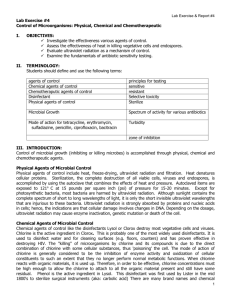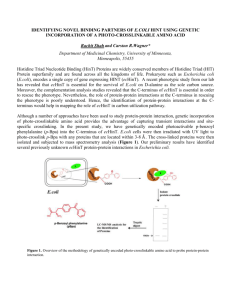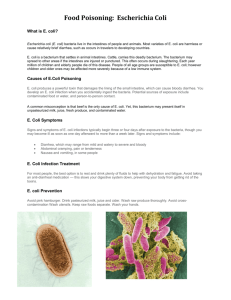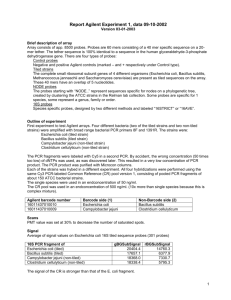Microbial Control Microbiology Lab Exercise Assignment
advertisement
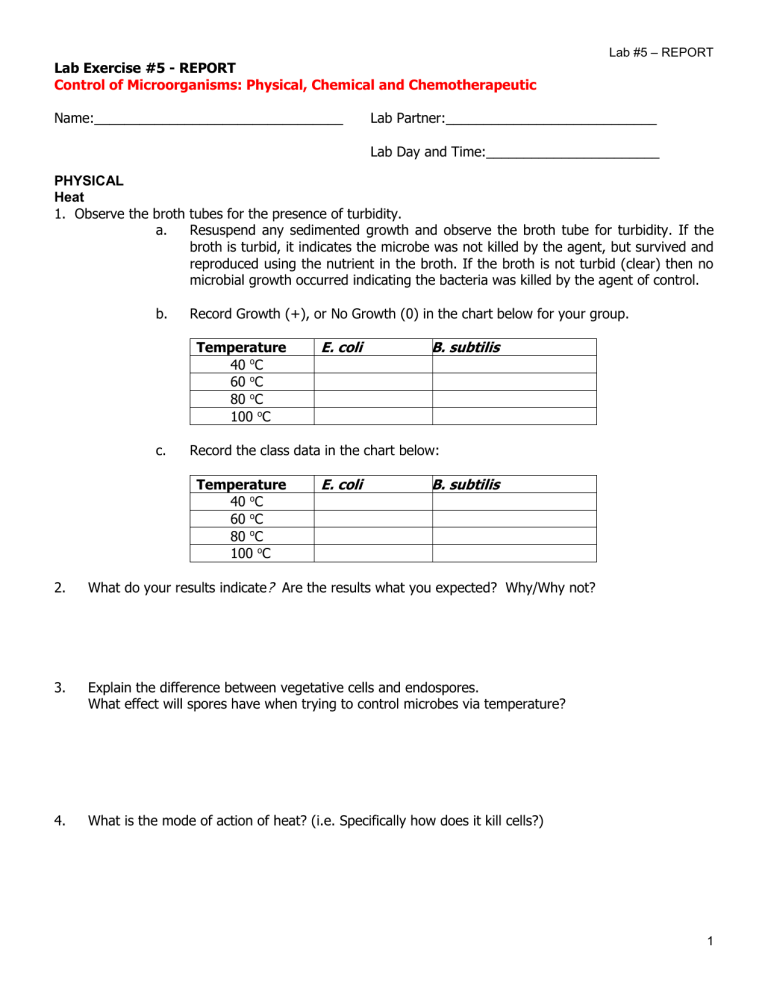
Lab #5 – REPORT Lab Exercise #5 - REPORT Control of Microorganisms: Physical, Chemical and Chemotherapeutic Name:_________________________________ Lab Partner:____________________________ Lab Day and Time:_______________________ PHYSICAL Heat 1. Observe the broth tubes for the presence of turbidity. a. Resuspend any sedimented growth and observe the broth tube for turbidity. If the broth is turbid, it indicates the microbe was not killed by the agent, but survived and reproduced using the nutrient in the broth. If the broth is not turbid (clear) then no microbial growth occurred indicating the bacteria was killed by the agent of control. b. Temperature WE. 40 oC 60 oC 80 oC 100 oC E 40 6040 oC 80 100 c. E 40 6040 oC 80 100 Record Growth (+), or No Growth (0) in the chart below for your group. E. Bacillus coli subtilis.BB. subtilis Record the class data in the chart below: Temperature WE. 40 oC 60 oC 80 oC 100 oC E. Bacillus coli subtilis.BB. subtilis 2. What do your results indicate? Are the results what you expected? Why/Why not? 3. Explain the difference between vegetative cells and endospores. What effect will spores have when trying to control microbes via temperature? 4. What is the mode of action of heat? (i.e. Specifically how does it kill cells?) 1 Lab #5 – REPORT 5. Would you use heat only, such as boiling water, as a mechanism of control? Explain why or why not. Ultra Violet Radiation 1. Draw each of the plates exposed to UV and their patterns of growth below. With lid Without lid 2. What do your results indicate? 3. Do you think you should remove the cover of the Petri dish when exposing the bacteria to the UV light? Why or why not? 2 Lab #5 – REPORT 4. What is the Mode of Action (MOA), (i.e. how does it work) of ultraviolet radiation. 5. What adverse effects can result from overexposure of human tissues to ultraviolet light? CHEMOTHERAPUTIC a. Observe for zones of inhibition. b. Measure the zones of inhibition from the back side of the plate using a metric ruler. c. Record the size of the zone of inhibition, if present, in millimeters. Manufacturers determine how large the zone of inhibition must be in order for the antibiotic to be considered effective for our purposes use the chart below. When zones of inhibition are greater than the number indicated the organism is sensitive to the antibiotic. When zones of inhibition are smaller than the number indicated, the organism is resistant to the antibiotic. Values that fall in between the numbers indicated result in a rating of "intermediate". 1. Record the results of the class data Individual Penicillin Erythromycin Ciprofloxacin Tetracycline Bacitracin Sulfadiazine Sensitive > 29 > 18 > 21 > 19 > 13 > 15 E. coli Results S. epi Class Resistant < 20 < 13 < 16 < 14 <8 < 12 E. coli data S. epi 3 Lab #5 – REPORT 2. Identify the MOA and the intended microbial target (type of bacteria that are susceptible) of each of the following antibiotics. Antibiotic Penicillin Target Mode of Action Erythromycin Ciprofloxacin Tetracycline Bacitracin Sulfadiazine 4 Lab #5 – REPORT CHEMICAL Results with Clorox Label conc. E. coli 1 0-1 Bacillus E. coli subtilus 10-2 Bacillus E. coli subtilus 10-3 Bacillus E. coli subtilus 10-4 Bacillus E. coli subtilus Bacillus subtilus Results with Lysol Label conc. E. coli 1 0-1 Bacillus E. coli subtilus 10-2 Bacillus E. coli subtilus 10-3 Bacillus E. coli subtilus Bacillus E. coli subtilus 1. Which one would you choose to use based on your results? Why? 2. Are you results consistent with what you would expect? Why or why not? 3. 10-4 Bacillus subtilus Do either of these agents appear to work on endospores? 4. How effective are these agents against viruses? (You need to do some online or textbook research for this one.) 5. What are some of the limitations of these products? (You need to do some online or textbook research.) This material is adapted from the Applied Microbiology Laboratory Manual by Cynthia Schauer. For Power Point slides that correspond to this lab material, see the Virtual Microbiology Classroom of the Science Prof Online website. 5



